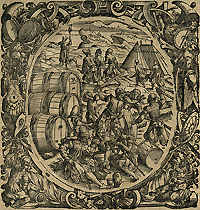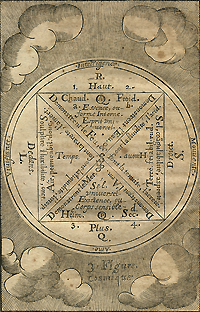The Chemical Philosophy

Camp scene showing Renaissance period troops. From Paracelsus, Grosse Wundarznei, Erster Theil (Franckfurt am Main, 1565).
At the time of his death Paracelsus seems to have been well known as a physician, but not as an author. He had published several almanacs and a few medical works, but only one major text, the Grosse Wundartzney (1536) which had gone into a second edition the following year. Here he appeared as a medical practitioner discussing wounds, ulcers, and their cure with salves and balms. A particularly interesting section treats the wounds caused by gunpowder -- clearly a reflection of a growing problem in sixteenth-century warfare.
It was well over a decade after his death before physicians began to look for his manuscripts and to publish them -- frequently with commentaries of their own. By 1570 many of his works were in print along with treatises written by a growing number of disciples. In these works we find a strong challenge to the educational establishment and its reliance on ancient authorities. Some Paracelsians took pride in the fact that they had not gone to the universities at all, thus avoiding the useless knowledge they would have been subjected to. Those who did not go to the universities turned instead to the two-book theory -- reliance on Holy Scripture and on personal observations and experience. Here they found chemistry particularly valuable since it separated pure from impure. Beyond this, chemistry became a basis for explaining both macrocosmic and microcosmic phenomena. Even the Creator was pictured as a divine alchemist in commentaries on the first chapter of Genesis.

Renaissance surgical scene. From Paracelsus, Opus chyrurgicum ... und Artzney Buch (Franckfurt am Mayn, 1565)
The Paracelsians differed sharply from the ancients in their discussion of mathematics. In his summary of Paracelsian medicine, Peter Severinus argued that Aristotle's work as well as Galen's was flawed by its overemphasis on mathematical logic (1571). The use of weights and measures was acceptable for the physician -- and even the mystical use of numbers as one might find in the hermetic texts -- but not the logical-geometrical use of mathematics. Far more acceptable was the analogy of the great world and man which might be used as a guide to truth. Paracelsus had written that "everything which astronomical theory has searched deeply and gravely by aspects, astronomical tables and so forth, -- this self-same knowledge should be a lesson and teaching to you concerning the bodily firmament." Another object of the Paracelsians' attack was the ancient system of elements: Earth, Air, Water and Fire with their attendant qualities and humors. This was a complex system, but a potentially fragile one, since a rejection of even one might result in a collapse of the whole. The Paracelsians argued that nowhere in Holy Scripture is there reference to the creation of fire and therefore it cannot be considered an element. Still, the four elements were not categorically denied by all, and in the course of the seventeenth century a five element/principle system evolved in the works of the chemists and the chemical physicians.

Diagram illustrating the convergence of elements, humors, and geocosmic factors in the thinking of Paracelsian chemical physicians. From Annibal Barlet, Le Vray et methodique Cours de ... Chymie (Paris, 1653).
Element theory was only one aspect of macrocosmic interest. If the Creation was to be understood primarily as an alchemical separation from an initial chaos, then it seemed appropriate to use this analogy in geocosmic explanations. Distillation was the model employed for rain, volcanic eruptions, and the origin of mountain streams. Indeed, the earth itself was viewed as a large distillation flask with a fiery center which heated underground reservoirs and lava both of which might erupt at the surface.
But if the Paracelsians rejected much of the ancient legacy, they remained wedded to the ancient vitalistic world view. Metals originated in the earth from a union of an astral seed with a proper matrix. The resultant ore matured in the earth much as a fetus in the mother. And indeed, there is a life spirit that is essential for both the organic and the inorganic worlds. By the final decade of the sixteenth century this spirit was identified as an aerial niter or saltpeter.

